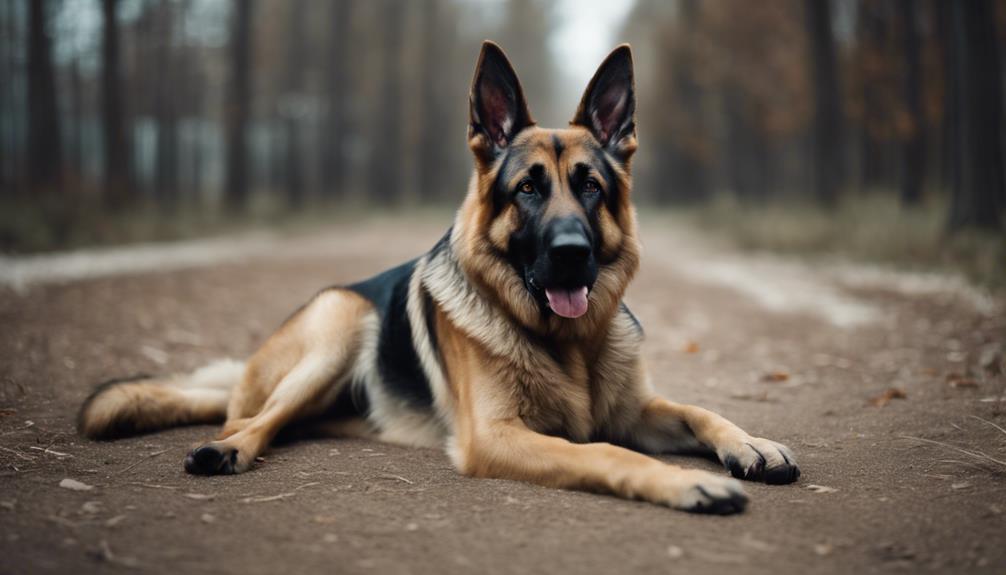🐾 Paw-some Partnership Alert! 🐾
As a pack of German Shepherd enthusiasts at MixGermanShepherd.com, we're always sniffing out the best products for our furry friends. Guess what? When you fetch something from Amazon through our links, we earn a little treat! 🦴
In the world of canine companions, the German Shepherd and the Belgian Malinois stand as stalwarts, each with its unique set of characteristics and qualities. Initially bred for different purposes, these breeds share traits that make them exceptional partners for the right owner. As you explore their origins, physical attributes, temperaments, and training needs, a fascinating journey unfolds, offering insights into which breed might align best with your lifestyle and preferences. Familiarize yourself with the nuances of these remarkable breeds to make an informed decision that will shape your bond with your furry companion for years to come.
Key Takeaways
- German Shepherds are generally heavier with a robust build, while Belgian Malinois have a leaner, athletic physique.
- Belgian Malinois are high-energy dogs requiring more stimulation, whereas German Shepherds are adaptable and calm in different environments.
- German Shepherds have a broader head and softer lines, contrasting with the sharper features and darker eyes of Belgian Malinois.
- Both breeds require specific training methods and exercise routines, with Belgian Malinois excelling in agility and speed tasks.
Breed Origins Comparison
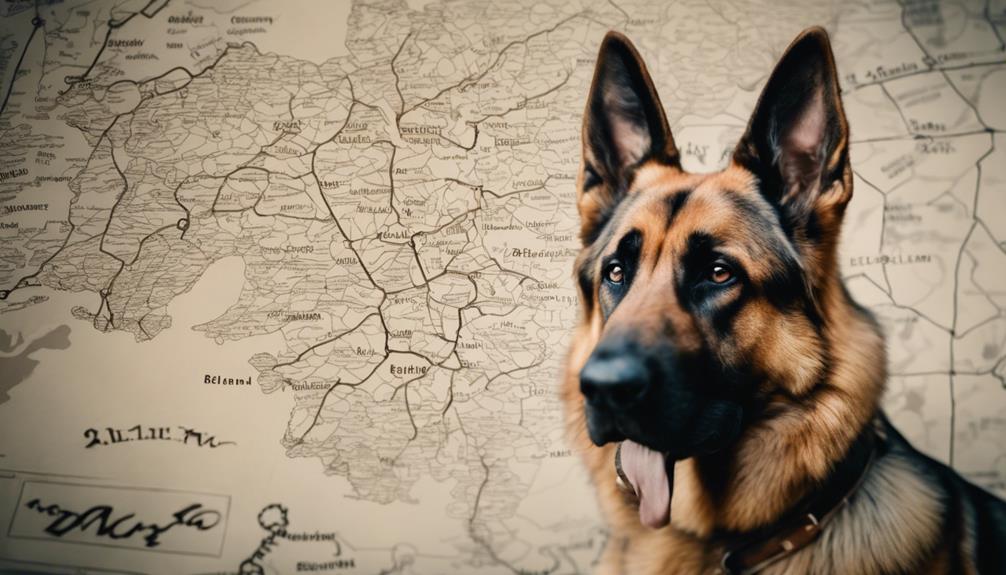
Comparing the origins of the German Shepherd and the Belgian Malinois reveals distinct historical developments that shaped these two renowned breeds in the canine world. The German Shepherd, developed by Captain Max von Stephanitz in the late 19th century, was originally bred for herding purposes. However, its intelligence, strength, and versatility soon made it a prime candidate for police and military work. World War I played a significant role in the breed's history, with anti-German sentiment leading to the temporary name change to 'Alsatians.' On the other hand, the Belgian Malinois, part of the Belgian shepherd group refined in the late 1800s, stands out as the only short-coated breed in this category. Known for its exceptional herding abilities, the Belgian Malinois quickly found its niche in police and military roles due to its agility, keen intellect, and unwavering loyalty. The distinct paths taken by these breeds in terms of historical development have influenced their characteristics and roles in society, with the German Shepherd excelling in a broader spectrum of tasks while the Belgian Malinois has become a specialist in specific fields such as law enforcement and defense.
Physical Characteristics Examination
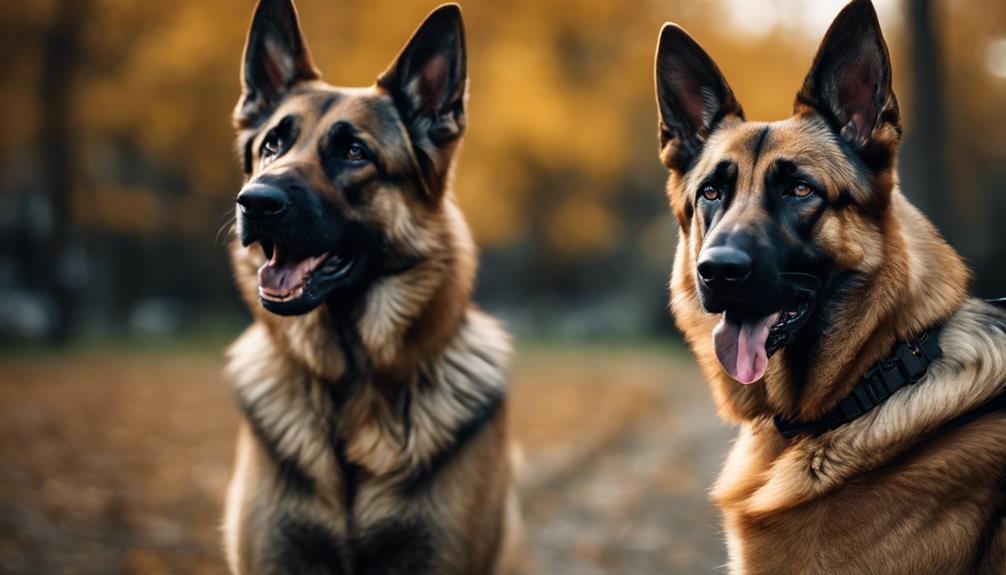
When comparing the physical characteristics of the German Shepherd and Belgian Malinois, it becomes evident that their size and build, coat color variations, and facial features play significant roles in distinguishing between the two breeds. These differences are crucial markers for breed identification and have practical implications in understanding their distinct traits and behaviors. By analyzing these points, a clearer picture emerges of the unique physical attributes that set these two breeds apart.
Size and Build
In examining the size and build of German Shepherds and Belgian Malinois, notable differences become apparent, particularly in their weight ranges and physical structures. German Shepherds are known for their robust build, with males weighing between 50-90 pounds and females between 40-80 pounds. They have a deeper chest and a longer body structure, allowing for efficient ground coverage. On the other hand, Belgian Malinois exhibit an athletic physique, with males weighing 60-80 pounds and females 40-60 pounds. Despite similar heights, German Shepherds are generally larger, about 10% more massive than Belgian Malinois on average. Below is a comparison table highlighting the key size and build differences between German Shepherds and Belgian Malinois:
| Characteristic | German Shepherds | Belgian Malinois |
|---|---|---|
| Weight Range | 50-90 pounds (male), 40-80 pounds (female) | 60-80 pounds (male), 40-60 pounds (female) |
| Physical Structure | Robust build with a deeper chest and longer body | Athletic physique with a square frame |
Coat Color Variations
Moving from the discussion on Size and Build, the distinct coat color variations between Belgian Malinois and German Shepherds provide key visual cues to differentiate these two breeds.
- Belgian Malinois feature fawn to mahogany coat colors with black overlay, mask, and ears, giving them a unique appearance.
- German Shepherds are typically seen in classic black and tan or black and silver coat coloring, setting them apart from Belgian Malinois.
- The black mask and ears often present in Belgian Malinois can help distinguish them from German Shepherds at a glance.
- German Shepherds exhibit a range of coat colors, including sable, all-black, and less common shades like blue and liver, adding to their diverse appearance.
These coat color variations serve as prominent distinguishing features between Belgian Malinois and German Shepherds.
Facial Features Differences
Facial features distinguish the Belgian Malinois and German Shepherd breeds with notable variations in head structure and eye coloration, contributing to their distinct appearances. Belgian Malinois exhibit sharper features, characterized by a lean build and darker eyes, while German Shepherds are recognized for their broader heads with softer lines and larger paws supporting a heavier build. Tail carriage also sets them apart, as Belgian Malinois may carry their tails lower than German Shepherds, whose tails often hang near their hocks. Observing paw size and tail carriage can provide insights into breed traits under different conditions. Additionally, the German Shepherd's unique and efficient gait aids in effectively covering ground, showcasing another aspect of their distinctive physical characteristics.
Temperament Variations Analysis
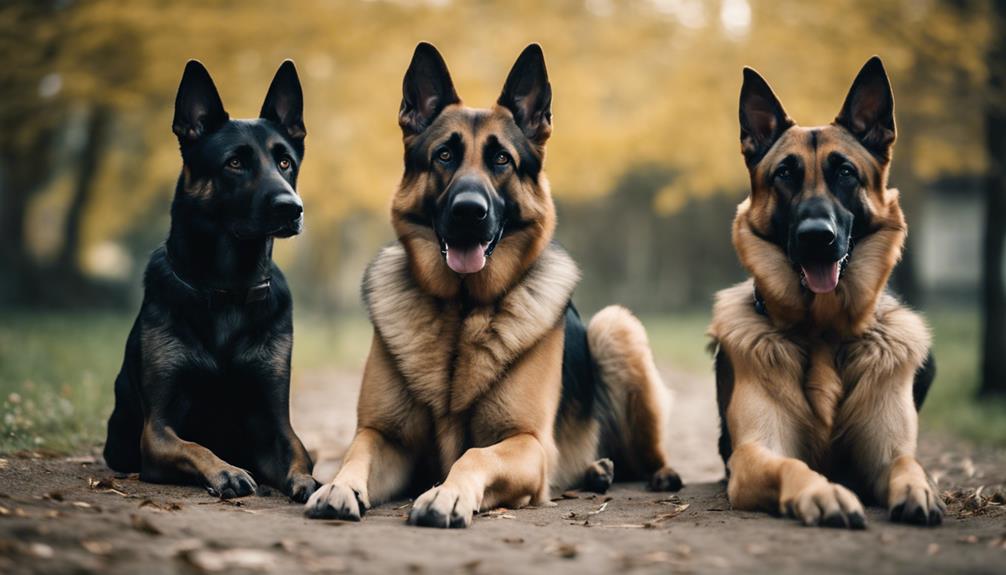
Analyzing the temperament differences between German Shepherds and Belgian Malinois reveals distinct behavioral traits that cater to varying lifestyle needs and preferences.
- High Energy Levels: Belgian Malinois are known for their high energy levels and need for mental and physical stimulation, requiring an active and engaging lifestyle to thrive.
- Protective Nature: German Shepherds exhibit a calmer demeanor and are more protective, making them well-suited as family and guard dogs, providing a sense of security.
- Agility and Speed: While both breeds are intelligent and loyal, Belgian Malinois excel in agility and speed tasks, showcasing their athleticism and quick responsiveness.
- Adaptability vs. Thriving in Challenges: German Shepherds are more adaptable to different environments, adjusting well to various situations. In contrast, Belgian Malinois thrive in active and challenging environments, constantly seeking tasks to stimulate their minds and bodies.
Understanding these temperament variations is essential in selecting the right breed that aligns with your lifestyle and preferences. Whether you seek a loyal guardian with a protective instinct like the German Shepherd or a highly energetic and agile companion like the Belgian Malinois, each breed offers unique qualities suited to different living situations and activities.
Training Requirements Evaluation
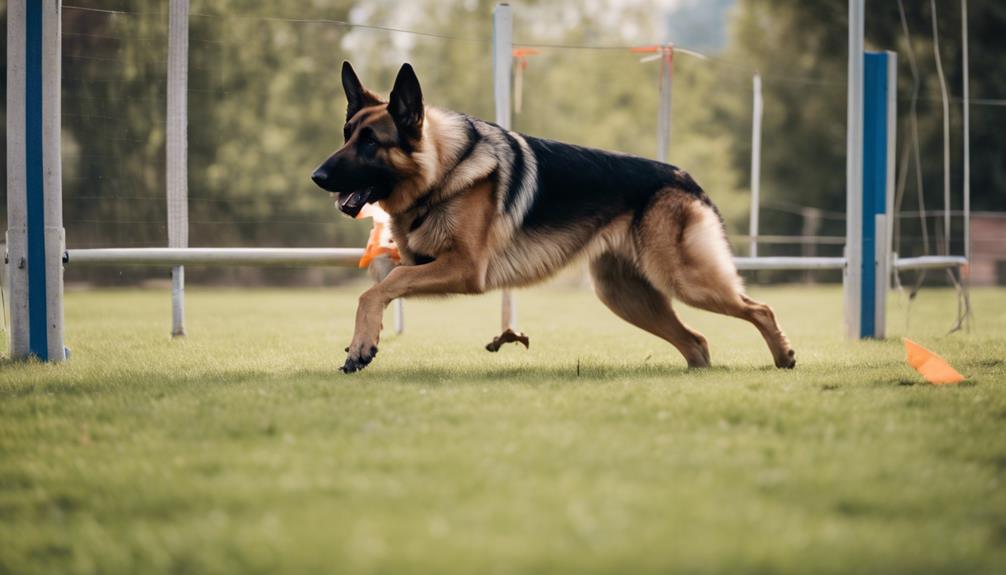
Understanding the temperament variations between Belgian Malinois and German Shepherds sheds light on the crucial training requirements needed to nurture their distinct behavioral traits effectively. Both breeds require consistent and firm training methods to thrive. However, Belgian Malinois are generally considered slightly easier to train due to their independent nature, while German Shepherds may display separation anxiety, necessitating patient and positive reinforcement training techniques.
To ensure successful training outcomes for Belgian Malinois and German Shepherds, it is imperative to provide mental stimulation and maintain training consistency. Behavioral issues can arise if these aspects are overlooked. Patience plays a vital role in the training process, especially when emphasizing positive reinforcement techniques.
| Training Requirements | Belgian Malinois | German Shepherds |
|---|---|---|
| Independent Nature | Easier to train due to independence | May exhibit separation anxiety |
| Behavioral Issues | Requires mental stimulation | Emphasize consistency in training |
| Positive Reinforcement | Respond well to this technique | Essential for addressing anxiety |
| Patience | Key in training process | Crucial when dealing with anxiety |
Health Considerations Contrast
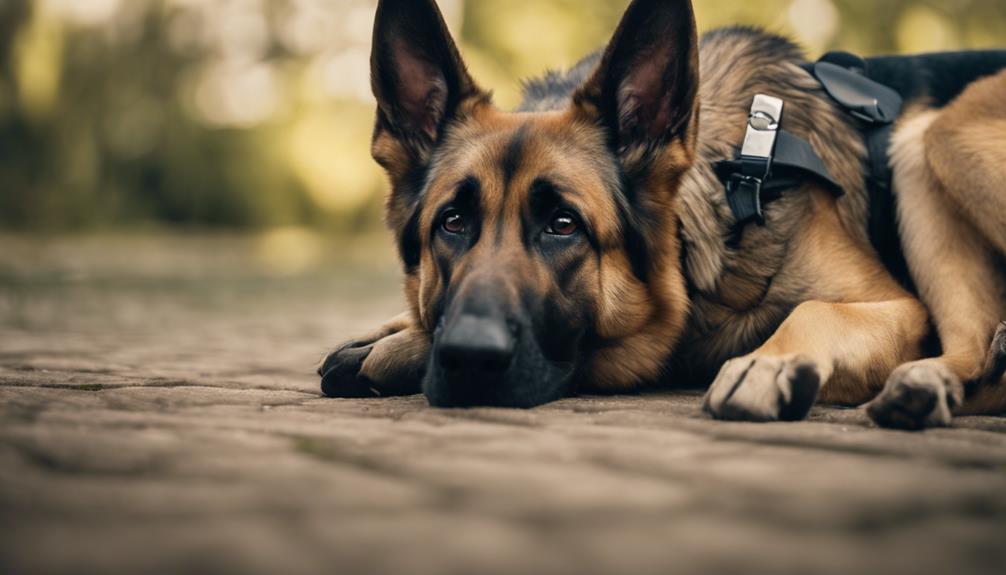
When comparing the health considerations between Belgian Malinois and German Shepherds, one notable distinction is the difference in susceptibility to various genetic health issues. Here are some key points to consider:
- Joint Health: Belgian Malinois are less prone to joint dysplasia and certain eye issues compared to German Shepherds. This makes them a more reliable choice for activities that involve agility and physical demands.
- Hip Dysplasia and Degenerative Myelopathy: German Shepherds are more susceptible to hip dysplasia and degenerative myelopathy, conditions that can significantly impact their mobility and quality of life. These health issues are less common in Belgian Malinois.
- Bloat: German Shepherds have a higher predisposition to bloat, a life-threatening condition where the stomach fills with gas or fluid. Belgian Malinois have a lower risk of developing this serious issue.
- Allergies and Breed-specific Health Concerns: Both breeds can experience allergies, but Belgian Malinois have a lower risk of certain breed-specific health issues. When considering the overall health profile, Belgian Malinois may offer a more robust and reliable option for work-related tasks, especially in demanding fields like police and military work.
Considering these health factors is crucial when deciding which breed is better suited for specific tasks or as a companion animal.
Choosing the Right Breed Decision-making
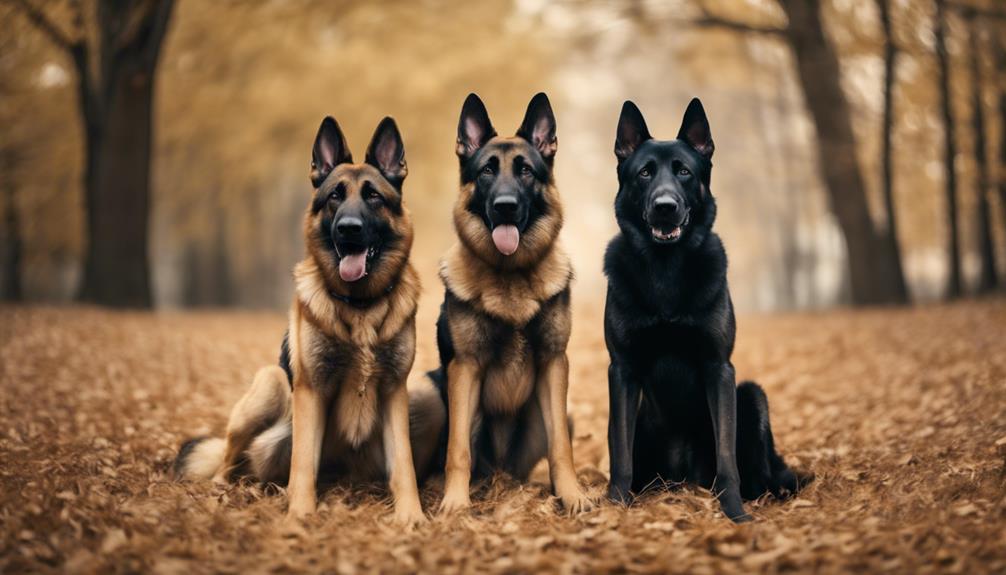
To make an informed decision between a Belgian Malinois and a German Shepherd, carefully assess your lifestyle, activity level, and training capabilities. The Belgian Malinois is known for its high energy levels, requiring vigorous exercise and mental stimulation. In contrast, the German Shepherd is generally calmer and may be more suited to a less active lifestyle. Consider your daily routine and how much time you can dedicate to exercising and engaging with your chosen breed.
Regarding training commitment, the Belgian Malinois is often described as highly intelligent but can be willful, needing consistent training and socialization. On the other hand, the German Shepherd is known for its trainability and loyalty, making it a suitable choice for first-time dog owners or those with less time for intensive training sessions.
When evaluating exercise needs, keep in mind that the Belgian Malinois may require more physical activity to prevent boredom and destructive behaviors. Comparatively, the German Shepherd's exercise requirements can be met through regular walks and playtime.
Temperament-wise, the Belgian Malinois is typically more intense and may exhibit protective instincts, while the German Shepherd is known for its versatility and adaptability in various roles.
Consider the popularity and availability of both breeds in your area to ensure you can find a reputable breeder or rescue organization. By carefully weighing these factors, you can make a well-informed decision that aligns with your preferences and lifestyle.
Frequently Asked Questions
Which Breed Is Better German Shepherd or Belgian Malinois?
When deciding between a German Shepherd and a Belgian Malinois, consider training methods, exercise requirements, temperament differences, grooming needs, socialization techniques, health considerations, breed history, living situations, obedience training, and behavioral quirks to make an informed choice.
Are Malinois More Intelligent Than German Shepherds?
In terms of cognitive abilities and problem-solving skills, Belgian Malinois often exhibit a higher level of intelligence compared to German Shepherds. Their quick learning speed, mental challenges, and adaptability in working tasks showcase their advanced mental capabilities.
Who Would Win in a Fight Between a German Shepherd and a Belgian Malinois?
In a fight between a German Shepherd and a Belgian Malinois, size difference, bite force, temperament comparison, training methods, protective instincts, agility skills, energy levels, dominance behavior, working abilities, and breed loyalty all play a role in determining the outcome.
Why Do Police Use Belgian Malinois Instead of German Shepherd?
Police use Belgian Malinois instead of German Shepherds due to their higher pain tolerance, resilience in challenging environments, exceptional scent detection abilities, and versatility in specialized operations. They excel in training, agility, and exhibit strong protective instincts.
Conclusion
In the world of canine companions, the German Shepherd and Belgian Malinois stand as stalwart guardians, each with their own unique strengths and characteristics. Like two knights in shining armor, they offer unwavering loyalty and protection to those they serve. While the German Shepherd may be the steadfast defender, the Belgian Malinois is the agile warrior, ready to spring into action at a moment's notice. Choose wisely, for your choice will shape the bond you share with your noble canine companion.
